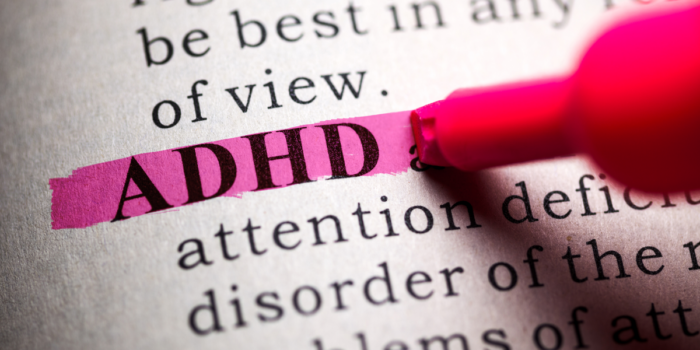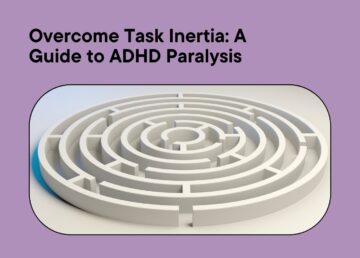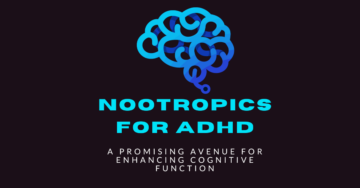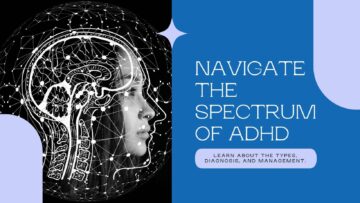
While many people associate attention deficit hyperactivity disorder (ADHD) with symptoms such as lack of attention and hyperactivity, the condition is still often misunderstood, especially the inattentive type.
This is because the symptoms, such as difficulty sustaining attention, forgetfulness, and disorganization, are often misperceived as laziness or lack of motivation.
In this article, we will discuss inattentive ADHD, how it presents, its causes, inattentive ADHD symptoms, how it differs from predominantly hyperactive-impulsive presentation, and how to tackle the symptoms.
In this article
An overview of inattentive ADHD
ADHD is a neurodevelopmental disorder that affects the brain by disrupting the normal functioning of neurotransmitters, particularly dopamine and norepinephrine, which play a role in regulating attention and behavior.
The disorder is most often classified into three subtypes:
- Inattentive type
- Hyperactive type
- Combined type
Individuals who appear forgetful and have problems with attention (some resources classify them as ADD symptoms) but display few or no symptoms of hyperactivity or impulsivity are said to have predominantly inattentive ADHD.
Definition and clarification: inattentive ADHD explained
ADHD can affect anyone, despite their age. However, while adults learn to navigate the world through learned behaviors, inattentiveness can have a huge impact on a child’s life.
Children may struggle with homework or completing assignments, forget school materials, have mood swings, and have difficulty making friends. For other children, inattentive ADHD can sometimes be mistaken for a learning disability such as dyslexia.
Family members should pay close attention to children and their behaviors and consult medical professionals if problems arise. While there is no cure for the disorder, it can be successfully treated with medications, lifestyle changes, and therapy.
ADHD can also manifest differently in genders. Women with ADHD usually experience internalized symptoms, such as anxiety, being easily distracted, or daydreaming.
Symptoms in men tend to be more externalized. While women also experience hyperactivity, it is usually not expressed externally.
Research suggests that women are diagnosed with inattentive type ADHD more frequently than men, although this may be partly due to differences in presentation and diagnosis.
The causes behind inattentive ADHD
Individuals with ADHD are generally born with the disorder, but signs can emerge or become more pronounced during certain life stages, such as puberty, pregnancy, or menopause.
The exact causes of attention deficit hyperactivity disorder are not yet fully understood. It is suspected that both genetics and environmental factors play a role.
Biological and environmental factors
Studies suggest that genetics have an impact on regulating transmitters that affect how neural networks communicate and function – genes can affect the production of dopamine and norepinephrine, which regulate attention, impulses, and behavior.
This means that attention deficit hyperactivity disorder can be passed on genetically from parents to children. The heritability of this condition ranges from 60–90%.
However, environmental factors can also increase the risk. These risk factors can be classified into several categories:
- Exposure to substances, heavy metals, and chemicals
- Prenatal exposure to alcohol, tobacco, drugs, antidepressants, caffeine, etc.
- Pre-, peri-, and postnatal exposure to environmental toxins, such as mercury, manganese, lead, food additives (sodium benzoate), etc.
- Insufficient exposure to nutrients
- Lack of copper, folic acid, iron, omega-3 fatty acid, and zinc in pre-, peri-, and postnatal diet.
- Premature birth
- Childhood trauma
Debunking misconceptions: what inattentive ADHD is not
There are several misconceptions surrounding inattentive ADHD that need to be addressed to ensure accurate understanding and support for individuals with this condition.
- Inattentive ADHD is not a result of laziness or lack of intelligence. It is a disorder that affects the brain’s ability to regulate attention and focus, making it challenging to concentrate despite best efforts.
- Attention deficit hyperactivity disorder (ADHD) only affects children, and they will outgrow it. In reality, for many, the condition persists into middle school and adulthood. The presentation may change over time, but the core challenges with attention and organization remain.
- Inattentive ADHD is not merely a result of poor parenting or a lack of discipline. Environmental factors can influence symptom severity, but ADHD is primarily a biological condition with a genetic component.
- Inattentive ADHD is the same as attention deficit disorder (ADD). Previously, ADD was used to describe ADHD with few or no hyperactive-impulsive symptoms. However, later research found that people with the inattentive type of ADHD have internalized hyperactive symptoms. The term ADD was changed to a more inclusive ADHD.
Spotting inattentive ADHD: comprehensive symptom profile
Recognizing inattentive ADHD requires evaluating a pattern of specific symptoms that impacts daily life. It can be described by the following symptoms:
- Inability to stay focused: Individuals with inattentive ADHD may struggle to sustain attention, often losing track of details, becoming easily distracted, or having trouble paying attention even during enjoyable activities.
- Disorganization and forgetfulness: General forgetfulness, trouble organizing tasks, misplacing items, and difficulty staying organized are common signs. An inattentive adult might forget to pay bills, buy groceries, make or return phone calls, or do other activities.
- Avoidance of mentally demanding tasks: Due to difficulties with sustained attention, those with inattentive ADHD may avoid tasks that require intense mental effort, leading to underachievement despite having the potential to excel.
- Poor time management: Time management is a challenge for individuals with inattentive ADHD, as they often have what’s called “time blindness” – difficulty understanding the passing of time. This may lead to significant problems in meeting deadlines or being consistently punctual.
- Lack of focus on details: Individuals with attention deficit hyperactivity disorder may appear to be daydreaming or have difficulty focusing on details, particularly during conversations or when reading, thus leading to careless mistakes in schoolwork and personal projects for inattentive children and adults.
It’s important to note that some ADHD symptoms can be caused by other mental health conditions. For example, nervous system conditions like Tourette’s or a learning disorder such as dyslexia can be similar to primary symptoms of ADHD.
Diagnostic journey: how is inattentive ADHD identified?
Getting diagnosed typically begins with the observation of persistent symptoms by parents, teachers, and the individual themselves.
The process usually includes a comprehensive assessment of your medical history, developmental milestones, and family history to identify potential genetic links.
The diagnostic journey may include ruling out other possible explanations for the symptoms. Learning disorder or disability, anxiety, or mood disorder can sometimes present with similar features to inattentive ADHD.
Diagnostic criteria for inattentive ADHD
Centers for Disease Control and Prevention (CDC) suggests healthcare professionals use the criteria defined in the Diagnostic and Statistical Manual (DSM-5) by the American Psychiatric Association (APA).
As outlined in the DSM-5, specific symptoms must be present for at least 6 months and interfere with daily functioning. The criteria for the inattentive type are:
- At least six out of nine symptoms of inattention. The individual fails to pay close attention to details, makes careless mistakes, finds it difficult to maintain attention in demanding tasks, such as preparing reports at work, seems not to listen when spoken to, is forgetful, and distracted by external stimuli.
- Symptoms across multiple settings. The inattentive symptoms should be present in two or more settings – home, school, or work – to rule out situational factors.
- Symptoms interfere with functioning. The inattentiveness must lead to impairment in academic, occupational, social, or day-to-day activities, affecting the person’s ability to meet their potential. These could be forgetting to make or return phone calls, difficulty paying attention in classes, conversations, etc.
It’s essential to note that the diagnosis of the disorder should be based on a comprehensive evaluation conducted by a qualified healthcare professional who has experience in assessing ADHD.
Testing and assessment: what to expect
Testing for the disorder typically involves a multi-faceted approach to gather information about the individual indications, medical history, and functioning. The evaluation process may include:
- Clinical interviews: The healthcare provider will conduct interviews with the individual and their caregivers to understand the nature and duration of symptoms, as well as how they impact daily life.
- Rating scales and questionnaires: Standardized rating scales and questionnaires are often used to assess the severity and frequency of ADHD symptoms. These may be filled out by the individual, their parents, teachers, or other close observers.
- Behavioral and psychological testing: In some cases, additional psychological testing is done to rule out other conditions or to gain further insights into cognitive and behavioral patterns.
- Medical examination: A medical examination is essential to rule out any medical conditions.
The assessment process aims to gather comprehensive information to ensure an accurate diagnosis and help medical professionals develop a personalized treatment plan.
Collaboration with primary caregivers, teachers, and other professionals involved in the individual’s care is essential for a holistic understanding of the individual’s strengths and challenges.
Tackling inattentive ADHD: treatment and management strategies
The treatment involves a combination of evidence-based strategies. While there is no cure for ADHD or a one-size-fits-all method of treatment, a comprehensive approach can significantly improve quality of life.
Treatment typically includes a combination of ADHD medication, behavioral modification, and lifestyle changes. The primary goal is to improve attention, executive functions, and impulse control while fostering strengths and abilities.
Role of medication in managing inattentive ADHD
Medication can be a valuable tool in managing ADHD, particularly when indications significantly impair daily functioning.
- Stimulant ADHD medications, such as Adderall and Ritalin based treatments, are commonly prescribed to help regulate neurotransmitter levels in the brain, improving attention and focus.
- Non-stimulant medications like atomoxetine, monoamine oxidase inhibitors, or tricyclic antidepressants may also be prescribed as an alternative, especially for individuals who do not respond well to stimulants, have specific contraindications, or other health conditions that prevent usage of stimulants.
While medication can be effective on its own, it shows the best results when combined with behavioral therapy and other interventions to address the broader challenges.
Behavioral modification: therapy and coaching
Other effective treatments include behavioral therapy, coaching, and lifestyle changes.
Behavioral therapy provides individuals with practical solutions to improve organization, time management, and attention skills, as well as improve mental health in general. Nowadays there are numerous great apps available for this.
- Cognitive-behavioral therapy (CBT) is commonly used to help recognize unhelpful thought patterns and develop coping strategies to overcome challenges associated with inattention and impulsivity.
- Coaching is a specialized form of support that helps individuals set realistic goals, create action plans, build self-awareness, and consistently work on mental health.
The power of lifestyle changes: diet, exercise, and sleep
In addition to medication and behavioral strategies, lifestyle changes can significantly impact the management of this condition.
A well-balanced diet that includes nutrient-rich foods can support brain health and improve focus. Avoiding excessive sugar, caffeine, and processed foods may also help reduce fluctuations in energy and attention levels.
Physical activity can be beneficial – it increases blood flow to the brain, enhances neurotransmitter function, and improves overall mood and attention.
Adequate sleep is essential for everyone since poor sleep hygiene can lead to difficulties in focus and attention during the day.
Digital tools: Sensa
Sensa is a CBT-based app built with the help of mental health professionals that prepares daily lessons, tasks, activity-building strategies, and exercises to regulate emotions.
Understanding your condition is one of the most important steps to take when making a change for the better.
Hence, by using tools like Sensa, a person can learn how to complete tasks with ease, focus and remain concentrated, take care of an inattentive child, learn organizational skills, improve self-esteem, and much more.
It is essential to note that Sensa is not a replacement for therapy or medical treatment but rather a supplementary tool to help ease struggles caused by the condition. Consult a qualified healthcare provider for personalized care if your indications severely interfere with your daily life.
Living with inattentive ADHD: practical tips and insights
ADHD can present unique challenges, but with the right strategies, you can enhance your productivity and improve prioritization and other skills.
However, by building solid routines and daily rituals, you can ease the challenges that affect your life.
Navigating daily life: productivity and organizational tips
Creating a quiet workspace, using noise-canceling headphones, or implementing the Pomodoro Technique (working in focused intervals with short breaks) can aid concentration.
Additionally, incorporating regular breaks during tasks can help prevent mental fatigue and increase overall productivity.
If remembering tasks is challenging, consider using scheduled reminders, calendar events, and alarms, using a planner, or other systems that work for you.
Building support systems: the importance of understanding and acceptance
Seeking understanding and acceptance from family, friends, and colleagues can create an environment where you feel validated and less judged. Sharing insights and successes can also provide a sense of belonging and reduce feelings of isolation.
Offer support and understanding for children with ADHD, as they likely don’t have the skills to manage their disorder. The National Institute of Mental Health (NIMH) suggests helping children come up with their own solutions to being organized and less distracted.
Additionally, you might want to seek professional support from doctors, therapists, coaches, or counselors to receive personalized guidance and tools to navigate the challenges of daily life.
Embracing life with inattentive ADHD
While living with a predominantly inattentive type of ADHD may have its share of obstacles, embracing self-compassion and acknowledging strengths and successes are equally important.
Selecting effective treatment options, and celebrating achievements, no matter how small, can build confidence and motivation. With understanding, support, and practical strategies, individuals with ADHD can thrive and lead fulfilling lives.
Frequently Asked Questions
What are the 9 symptoms of inattentive ADHD?
Individuals with inattentive ADHD may experience nine primary symptoms, including:
- Easy distractibility: Being easily distracted by external stimuli, such as sounds, movement, or conversations, can hinder concentration and task completion.
- Frequent daydreaming or mind wandering: Difficulty staying focused on the present moment and engaging in frequent daydreaming or mind wandering can disrupt attention and make it challenging to follow instructions or complete tasks.
- Difficulty following instructions or completing tasks: Difficulty comprehending and adhering to instructions or completing tasks due to distractibility and focus issues can lead to missed deadlines, errors, and frustration.
- Difficulty organizing tasks or activities: Challenges in planning, prioritizing, and organizing tasks or activities can result in procrastination, disorganization, and difficulties managing time effectively.
- Losing items or forgetting important information: Frequent misplacing of items, such as keys, phones, or important documents, and difficulty remembering names, dates, or appointments can add to daily challenges.
- Being easily overwhelmed by tasks: Difficulty handling multiple tasks or complex instructions simultaneously can lead to feelings of overwhelm, frustration, and the inability to manage multiple responsibilities.
- Avoidance of tasks that require sustained focus: Tendency to procrastinate or avoid tasks that demand sustained focus, such as studying, reading, or attending meetings, due to persistent difficulties maintaining concentration.
- Poor time management: Difficulty estimating time accurately and managing time effectively can lead to missed deadlines, rushed work, and overall inefficiency.
- Difficulty listening to others: Difficulty concentrating on conversations, remembering what others have said, and following instructions can hinder communication and social interactions.
What can you do to help inattentive ADHD?
Managing inattentive ADHD involves a combination of lifestyle modifications, self-help strategies, and professional support. Here are some effective approaches to address inattentive ADHD symptoms:
- Lifestyle Modifications: a. Regular Exercise: Engaging in regular physical activity improves focus, reduces restlessness, and regulates emotions. Aim for at least 30 minutes of moderate-intensity exercise most days of the week.b. Nutritious Diet: A balanced diet rich in fruits, vegetables, and whole grains provides the essential nutrients needed for optimal brain function. Avoid excessive sugar and processed foods, which can contribute to hyperactivity and mood swings.c. Adequate Sleep: Sufficient sleep, typically 7-8 hours per night, allows the brain to rest and recharge, enhancing concentration and impulse control. Establish a regular sleep schedule and create a relaxing bedtime routine.
- Self-Help Strategies: a. Identifying Triggers: Recognizing personal triggers that exacerbate inattention can help minimize their impact. Avoid overly stimulating environments, prioritize tasks, and break down complex projects into smaller steps.b. Organizational Tools: Utilize planners, calendars, and to-do lists to manage tasks, stay on track, and reduce procrastination. Create a designated workspace free from clutter to enhance focus.c. Positive Self-Talk: Engage in positive self-talk to combat negative thoughts and enhance self-esteem. Remind yourself of your strengths and capabilities, and focus on progress rather than perfection.d. Mindfulness Practices: Incorporating mindfulness techniques, such as meditation or yoga, can help reduce stress, improve focus, and regulate emotions. These practices promote self-awareness and enhance the ability to manage distractions.
- Professional Support: a. Psychotherapy: Cognitive Behavioral Therapy (CBT) can help address underlying thought patterns that contribute to inattention. CBT teaches individuals to identify and change negative thoughts and behaviors.b. ADHD Coaching: A specialized ADHD coach can provide personalized guidance and strategies to manage symptoms, enhance organization, and improve time management skills.c. Medication: In some cases, medication may be prescribed to help manage ADHD symptoms. Stimulant medications can improve focus and reduce distractibility.
What are the behaviors of inattentive ADHD?
Individuals with inattentive ADHD may exhibit various behaviors, including easy distraction, frequent daydreaming, difficulty following instructions, organizational challenges, misplacing items, overwhelm with tasks, avoidance of task-demanding activities, poor time management, and difficulties listening to others. These behaviors can significantly impact their daily life and require effective management strategies.
What does an inattentive ADHD person look like?
People with inattentive ADHD, also known as ADD or ADHD-PI, may exhibit various behaviors that can impact their appearance. These behaviors can include:
- Disorganization: Their physical appearance may reflect their struggles with organization, such as messy hair, wrinkled clothes, or disorganized workspaces.
- Spaced-out demeanor: They may appear distracted or disengaged, with glazed or vacant expressions, and may frequently lose their train of thought during conversations.
- Frequent fidgeting: They may exhibit restlessness or fidgeting behaviors, such as tapping their feet, twirling their hair, or playing with objects.
- Distracted by surroundings: Their attention may be easily drawn to external stimuli, causing them to miss or forget details during conversations or tasks.
- Lack of eye contact: They may struggle to maintain eye contact, making them appear disengaged or uninterested in conversations.
While these behaviors may affect their outward appearance, it’s important to note that individuals with inattentive ADHD have a range of strengths and abilities. They may be creative, insightful, and have a unique perspective on the world. With effective management strategies, they can thrive academically, professionally, and personally.
References:
- Milich, R., Balentine, A.C. and Lynam, D.R., 2001. ADHD combined type and ADHD predominantly inattentive type are distinct and unrelated disorders. Clinical psychology: science and practice, 8(4), p.463.
- Barkley, R.A., 2001. The inattentive type of ADHD as a distinct disorder: What remains to be done. Clinical psychology: Science and practice, 8(4), pp.489-493.
- Weiss, M., Worling, D. and Wasdell, M., 2003. A chart review study of the inattentive and combined types of ADHD. Journal of attention disorders, 7(1), pp.1-9.
- Goth-Owens, T.L., Martinez-Torteya, C., Martel, M.M. and Nigg, J.T., 2010. Processing speed weakness in children and adolescents with non-hyperactive but inattentive ADHD (ADD). Child Neuropsychology, 16(6), pp.577-591.
- Collings, R.D., 2003. Differences between ADHD inattentive and combined types on the CPT. Journal of Psychopathology and Behavioral Assessment, 25, pp.177-189.
- Hinshaw, S.P., 2001. Is the inattentive type of ADHD a separate disorder?.





